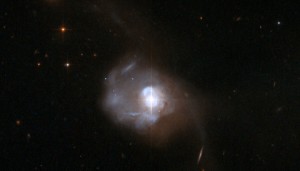A neighboring galaxy’s central black hole powers strong winds, allowing astronomers — for the first time — to spot those gales pushing out star-forming gas.

NASA / ESA
Most large galaxies contain supermassive black holes, which shine brightly when they gobble down gas in their environment. These so-called active galactic nuclei, or AGN for short, release torrents of energy into their surroundings. But astronomers debate whether the violent activity boosts or quenches star formation. The question is a crucial one, because it decides what role black holes play in a galaxy’s evolution.
Most AGN fired up in the early universe before fizzling out, but a few hotshots remain. Recently, an international team of astronomers took a closer look at Mrk 231 — an AGN some 600 million light-years away — and observed, for the first time, the AGN’s winds pushing away nearby star-forming gas.
“We think we have found evidence that the quasar outflow has collided with the gas and dust that is naturally produced as a part of star formation and evolution, pushing it away from the inner parts of the quasar host galaxy,” says lead author Karen Leighly (University of Oklahoma).
In most cosmological simulations, winds or jets from the AGN truncate star formation in the host galaxy, a necessary step that prevents the simulated galaxy from becoming too bright or massive as compared to real, nearby galaxies. But astronomers have never seen this directly — AGN are simply too distant.
So astronomers have learned indirect ways of investigating AGN's effect on their hosts. In the nearby universe, astronomers can group galaxies into two color groups: blue and red. Blue galaxies (such as the brilliant star forming spirals we see in so many Hubble images) contain many young and hot stars, whereas red galaxies contain older, cooler stars. But distant AGN host galaxies are found to lie in between the two extremes — in the so-called green valley — where they’re transitioning from blue to red, suggesting the star-forming days for these galaxies will soon be over.
But a few studies have seen just the opposite effect, where the supermassive black hole’s violent surroundings actually enhance star formation. Rather than push gas away, an AGN’s jet can induce shocks and turbulence in nearby gas, so it condenses and forms stars more quickly and efficiently.
These contradictory findings beg for a closer look. And Leighly and colleagues did just that, using data from the the NASA Infrared Telescope Facility, MDM Observatory, and the Apache Point Observatory to make detailed observations of Mrk 231.
“Mrk 231 offers a unique laboratory to study some aspects of galaxy formation,” Leighly says. As one of the closest AGN, she says, its proximity enables high-quality imaging and spectroscopy.
Those observations show that the AGN’s massive winds are running into, compressing, and accelerating gas in the galaxy’s center. Francoise Combes (Observatoire de Paris) says these findings are a significant advance.
But it remains unclear what role the winds play – are they hindering the gas’s ability to form stars? Leighly and colleagues predict that’s exactly what should happen as the quasar pushes the gas far from the galaxy’s center. If so, this would be the first direct evidence of an AGN quenching star formation.
Reference:
Karen M. Leighly et al. “Evidence for AGN Feedback in the Broad Absorption Lines and Reddening of Mrk 231,” to be published in The Astrophysical Journal.
 1
1









Comments
Peter Wilson
May 20, 2014 at 9:02 pm
Those observations show that the AGN’s massive winds are running into, compressing, and accelerating gas in the galaxy’s center.
This is confusing. I assume the AGN is in the galaxy’s center, ergo any winds from it should be coming from the galaxy’s center. Shouldn't they run into, compress and accelerate gas somewhere else?
You must be logged in to post a comment.
You must be logged in to post a comment.